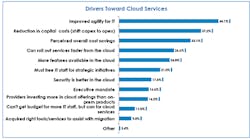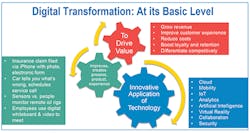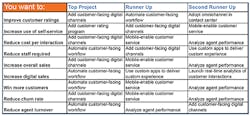Choosing the Right Cloud Communications Partner
End-user organizations are engaging in digital transformation initiatives designed to improve internal workflows and collaboration, as well as deliver new digital customer engagement experiences. To meet the need of rapidly developing new capabilities, they are increasingly turning toward cloud providers, and are looking for solutions that both provide off-the-shelf functionality and the ability to integrate communications features into existing internal and customer-facing platforms.
To meet this need, communications service providers must rapidly evolve their own offerings, delivering both packaged unified communications and customer engagement platforms, as well as customizable solutions that enable their customers to meet business needs. In developing these capabilities, service providers should look to partner with Communications Platform-as-a-Service (CPaaS) providers who provide global reach, high availability, and a broad and growing set of features that customers can use to achieve success in their digital transformation and customer experience initiatives.
The Customer Perspective: Driving Toward the Cloud
The pace of technology change continues to accelerate. Organizations are under constant threat of disruption to their business models, new competitors, and even potential elimination of the need for their products or services. Consider the rapid ways that companies like Uber, FreshDirect, Netflix, and AirBnB have radically transformed delivery, grocery shopping, music and movie consumption, and travel, respectively. At the same time that business leaders are trying to anticipate and react to threats, they are also developing and implementing their own digital transformation strategies to take advantage of the opportunities afforded by emerging technologies and achieve competitive advantage.
In this new paradigm, IT and business functions are increasingly becoming intertwined as IT is no longer a shared service providing basic communications and connectivity. Rather, IT becomes the primary platform for business. To achieve the speed of scale and agility
required to both protect against threats and exploit opportunities afforded by emerging technologies to gain competitive advantage, organizations are moving a growing percentage of their IT infrastructure to the cloud. Leading the way are often applications supporting collaboration, communications, and customer engagement.
In our 2018-19 unified communications and collaboration study, based on data gathered from more than 600 end-user organizations in North America, Europe, and Asia, we noted that for the first time "agility" became the top driver for adoption of cloud-based services. In 2018, 44.1% cited agility as a driver, versus just 29% in 2017. Cost reduction, while still important, has declined as a driver since 2016. Additional drivers related to agility include speed of deployment, access to features only available in the cloud, and the ability to shift IT staff from operational to strategic roles.
Drivers Toward Cloud Services
The Role of Communications in Digital Transformation
Nemertes defines digital transformation as the "innovative application of technology that improves or creates a process, product or experience that ultimately drives business value — quickly."
Digital Transformation Defined
Components of Digital Transformation
There are 4 main components to the definition, which are all interdependent on one another:
1. Innovates. This could mean the application of existing technologies or entirely new ones. The key is that the organization is using technology in a new way — a way that ultimately will start turning the gears.
2. Improves or creates a process, product, or experience. Because of that technology implementation (along with the right people, processes, and budgets — but that’s the next order down), something changes and, indeed, improves. A new communications service, for example, could enable multimedia messaging from a customer to a support agent, or calling from within a CRM application, tying records of conversations directly into customer accounts, thus enabling sales teams to have a better view into customer interactions.
InvisiLight® Solution for Deploying Fiber
April 2, 2022Go to Market Faster. Speed up Network Deployment
April 2, 2022Episode 10: Fiber Optic Closure Specs Explained…
April 1, 2022Food for Thought from Our 2022 ICT Visionaries
April 1, 20223. Drives measureable business value. Value could include cost savings, new revenues, process improvements, or other metrics that demonstrate a positive impact on overall business operation. For example, an innovative communications service could allow establishing local phone numbers in remote markets to make it easier, and cheaper for sales prospects to call, resulting in new sales opportunities that might previously have been lost.
4. Happens quickly. Digital transformation projects should show some definable result within 6 months. This doesn’t mean the entire transformation project must be complete within 6 months; it means there must be a checkpoint with measureable changes. Without this firm deadline, competitors may come out with something faster, stakeholders may lose interest, or budgets may dry up. This makes it even more vital to have a flexible communications service that makes it simple for remote and mobile staffs to connect quickly to make important decisions.
(Nemertes 2018-19 Digital Customer Experience study, based on data gathered from almost 700 companies, correlated digital technologies with the highest return on investment.)
Digital Customer Experience Projects
Selecting the Best Provider
Choosing the right partner requires assessing a variety of criteria including:
• Scope of offerings. If all you need is SMS services, then your pool of available partners is fairly large. But, if you want SMS "and" capabilities like virtual toll-free numbers in emerging markets, Multimedia Messaging Services (MMS), and on-net global calling from remote markets to minimize long distance costs, your choice of providers is more likely to be limited, and you are likely to benefit from partnering with a single CPaaS partner who can meet all of your needs, versus using different vendors for individual features.
• What the partner can offer today, and tomorrow. If the provider controls their own network, and has implemented an agile development approach with a DevOps-based methodology for operations, then they will be able to quickly deliver advanced capabilities as time goes by. As AI and machine learning become more widely available, software-based providers will have an edge in speed of delivery versus those wedded to legacy communications platforms.
• Regulatory compliance. Providers who can support regulations like E911 call routing, GDPR, and do-not-call registries will have an advantage over those who do not natively provide such capabilities and must instead work to integrate a variety of partners to deliver a broad service offering.
• Geographic reach. If your plans include support for global customers, look for a partner with points of presence within the countries you aim to serve.
• Reliability. CPaaS providers should be able to delivery highly reliable services, across their entire operating area, with rapid failover times. They should deliver monitoring and reporting capabilities that allows you to see exactly how services are performing, both in real-time and historically.
• Quality of Service. Providers with large numbers of interconnects to top tier carriers around the world are better able to provide high quality, reliable services than those with limited interconnection points and points of presence (PoPs). They will reduce the number of hops that calls must take transverse networks, as well as potential delays from transcoding between networks.
• Service and Support. Providers will often differentiate themselves on factors like mean time to repair, scope and availability of support (e.g., 7x24x365 versus business hours only), as well as customer ratings such as net promoter score (a measure of the likelihood that a customer is willing to recommend a service).
• Experience. Providers with long track records of providing globally available services have an advantage of startups or those with minimal service reach. Newer providers may not yet have infrastructure and support operations in place to scale to meet the needs of global enterprises.
Like this Article?
Subscribe to ISE magazine and start receiving your FREE monthly copy today!
Conclusion
Digital transformation is driving rapid change in the communications services market. End-user organizations, faced with the need to rapidly transform to survive and prosper, are increasingly embracing emerging, cloud-based communications services that enable them to better engage with customers, improve internal collaboration, and deliver new and differentiated services. As a result, they are embracing cloud-based services that offer rapid feature delivery, global scope, and customizable products.
Service providers should:
• Develop and deliver API-based offerings, and leverage existing offerings to improve the speed of delivery of services, and the available features to meet customer digital transformation needs.
• Evaluate a broad set of CPaaS partners that can give you what you need today, and grow with you over time, paying specific attention to their breadth, experience, and ability to rapidly deliver new features using agile, software-based, platforms.
• Strive to understand customer digital transformation needs and meet them with a mix of collaboration and customer engagement capabilities that integrate with existing applications.
About the Author:
This article is adapted from the white paper Choosing the Right Cloud Communications Partner: Not all Communications Platform-as-a-Service provides are created equal. For more information, please visit https://nemertes.com/research/choosing-the-right-communications-partner/.
Irwin Lazar is VP & Service Director, Nemertes Research. Nemertes is a global research-based advisory and consulting firm that analyzes the business value of emerging technologies. Since 2002, they have provided strategic recommendations based on data-backed operational and business metrics to help enterprise organizations deliver successful technology transformation to employees and customers. For more information about:
• Nemertes Research, please visit https://nemertes.com/.
• Flowroute, please visit https://www.flowroute.com/.







